The most powerful person in ancient Egypt was the pharaoh.
The pharaoh was the political and religious leader of the
Egyptian people, holding the titles: 'Lord of the Two Lands'
and 'High Priest of Every Temple'.
As 'Lord of the Two Lands' the pharaoh was the ruler of
Upper and Lower Egypt. He owned all of the land, made laws,
collected taxes, and defended Egypt against foreigners.
As 'High Priest of Every Temple', the pharaoh represented
the gods on Earth. He performed rituals and built temples to
honour the gods.
Many pharaohs went to war when their land was
threatened or when they wanted to control foreign lands. If
the pharaoh won the battle, the conquered people had to
recognise the Egyptian pharaoh as their ruler and offer him
the finest and most valuable goods from their land.
MUMMIFICATION
The
earliest ancient Egyptians buried their dead in small pits
in the desert. The heat and dryness of the sand dehydrated
the bodies quickly, creating lifelike and natural 'mummies'.
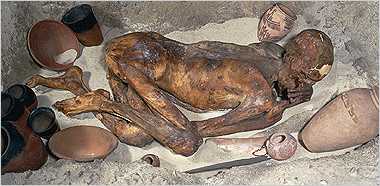
Later, the
ancient Egyptians began burying their dead in coffins to
protect them from wild animals in the desert. However, they
realised that bodies placed in coffins decayed when they
were not exposed to the hot, dry sand of the desert.
Over many centuries, the ancient Egyptians developed a
method of preserving bodies so they would remain lifelike.
The process included embalming
the bodies and wrapping them in strips of linen.
The
methods of embalming, or treating the dead body, that the
ancient Egyptians used is called mummification. Using
special processes, the Egyptians removed all moisture from
the body, leaving only a dried form that would not easily
decay. It was important in their religion to preserve the
dead body in as life-like a manner as possible. So
successful were they that today we can view the mummified
body of an Egyptian and have a good idea of what he or she
looked like in life, 3000 years ago.
Mummification
was practiced throughout most of early Egyptian history. The
earliest mummies from prehistoric times probably were
accidental. By chance, dry sand and air (since Egypt has
almost no measurable rainfall) preserved some bodies buried
in shallow pits dug into the sand. About 2600 B.C., during
the Fourth and Fifth Dynasties, Egyptians probably began to
mummify the dead intentionally. The practice continued and
developed for well over 2,000 years, into the Roman Period
(ca. 30 B.C. - A.D. 364). Within any one period the quality
of the mummification varied, depending on the price paid for
it.
The
best prepared and preserved mummies are from the Eighteenth
through the Twentieth Dynasties of the New Kingdom (ca. 1570
- 1075 B.C.) and include those of Tutankhamen and other
well-known pharaohs. It is the general process of this
period that shall be described here.
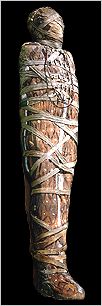
WHO
WAS MUMMIFIED
After
death, the pharaohs of Egypt usually were mummified and
buried in elaborate tombs. Members of the nobility and
officials also often received the same treatment, and
occasionally, common people. However, the process was an
expensive one, beyond the means of many.
For
religious reasons, some animals were also mummified. The
sacred bulls from the early dynasties had their own cemetery
at Sakkara. Baboons, cats, birds, and crocodiles, which also
had great religious significance, were sometimes mummified,
especially in the later dynasties.
Over
time almost all Egyptians who could afford to, became
mummies when they died -- a total of about 70 million
mummies in 3,000 years.
By the 4th century AD, many Egyptians had become Christians
and no longer believed that mummification was necessary for
life after death. Eventually, the Egyptians gave up the art
and science of making mummies.
So
where did all the mummies go?
Sadly, most were
plundered in ancient times by grave robbers and vandals
looking for treasures wrapped up in the bandages. Countless
mummies were also destroyed during the Middle Ages, when
they were ground into powders to make supposedly magical
potions. Later on, modern treasure hunters
blundered into their tombs looking for artifacts
and souvenirs. Even industry aided the
destruction by using mummies' bandages to make paper
or burning their bodies for fuel.
The
best preserved mummies are those of the pharoahs and their
relatives.
These mummies tended to be more
carefully embalmed and protected from harm. The mummies that
have survived allow us to look back into the past and know
something of the ancient Egyptians and their time. Three of
the most famous Egyptians mummies are Tutankhamen, Seti I
and Rameses II (Ramses the Great).
TUTANKHAMEN
Tutankhamen,
known to many as King Tut, was probably just a boy when he
was crowned pharoah in the 18th
Dynasty. He was still a teenager when he died of unknown
causes and was entombed in the Egyptian Valley of Kings.
Although Tutankhamen was not one of the more distinguished
or important pharoahs in his own time, he has a very special
place in ours.
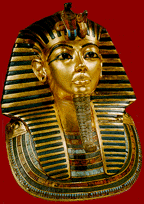
Tutankhamen's tomb was discovered in 1922 by Howard Carter.
Over the next several years, Carter's expedition carefully
uncoverd the riches within, including the gold mask above. A
number of mysterious deaths that followed the opening of the
tomb set off wild rumors of a mummy's curse.
Today, Tut is known to countless people the world over, in
part because his is the only pharoah's tomb ever discovered
intact. Tut's burial site had somehow escaped pillaging by
grave robbers for over 3000 years. His mummy and its
magnificent solid gold sarcophagus, along with wall
paintings, furniture, weapons, games and other artifacts
have survived to the present, giving us a unique glimpse at
the trappings of an ancient pharoah.
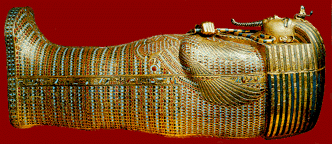

SETI
I
Seti I is considered to be one of the greatest of pharoahs
and warriors, and was also the father of another very
notable pharoah, Rameses II (or Rameses the Great). Seti
ruled in the 19th
Dynasty, several generations after Tutankhamen.
Surviving accounts of Seti's exploits tell us that he was
highly successful at protecting Egypt from such invaders as
the marauding armies of neighboring Libya. Seti was also
known to have extended his powers beyond the boundaries of
Egypt as far east as modern-day Syria.
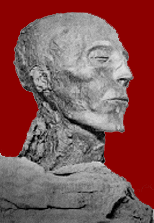
RAMESUS
Rameses the Great ruled over Egypt from 1279-1212
BC, an incredible 67 years. Rameses was legendary in
many respects. At a time when most people lived only a few
decades, Rameses was about 90 years old when he died. He was
a tall man about six feet in height, when the average
Egyptian was a little over five feet tall. Rameses had many
wives in his lifetime and is believed to have fathered over
100 children.
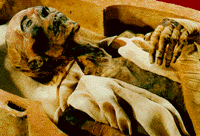
In 1974, Egyptologists at the Cairo Museum noticed that the
mummy's condition was getting worse rapidly . They decided
to fly Rameses II to Paris so that a team of experts could
give the mummy a medical examination. Did you know that even
a mummy needs a passport to travel? Ramses II was issued an
Egyptian passport that listed his occupation as "King
(deceased)."
Once in Paris, Rameses was diagnosed and treated for a with
a fungal infection. During the examination, scientific
analysis revealed battle wounds and old fractures, as well
as the pharoah's arthritis and poor circulation. In
addition, experts were able to determine some of the flowers
and herbs that were used for the embalming, including lots
of camomile oil.
THE
MUMMIFICATION PROCESS
The
mummification process took seventy days. Special priests
worked as embalmers, treating and wrapping the body. Beyond
knowing the correct rituals and prayers to be performed at
various stages, the priests also needed a detailed knowledge
of human anatomy.
The
first step in the process was the removal of all internal
parts that might decay rapidly. The brain was removed by
carefully inserting special hooked instruments up through
the nostrils in order to pull out bits of brain tissue. It
was a delicate operation, one which could easily disfigure
the face. The embalmers then removed the organs of the
abdomen and chest through a cut usually made on the left
side of the abdomen.
They
left only the heart in place, believing it to be the center
of a person's being and intelligence. The other organs were
preserved separately, with the stomach, liver, lungs, and
intestines placed in special boxes or jars today called
canopic jars. These were buried with the mummy. In later
mummies, the organs were treated, wrapped, and replaced
within the body. Even so, unused canopic jars continued to
be part of the burial ritual.
The
embalmers next removed all moisture from the body. This they
did by covering the body with natron, a type of salt which
has great drying properties, and by placing additional
natron packets inside the body. When the body had dried out
completely, embalmers removed the internal packets and
lightly washed the natron off the body. The result was a
very dried-out but recognizable human form. To make the
mummy seem even more life-like, sunken areas of the body
were filled out with linen and other materials and false
eyes were added.
Next
the wrapping began. Each mummy needed hundreds of yards of
linen. The priests carefully wound the long strips of linen
around the body, sometimes even wrapping each finger and toe
separately before wrapping the entire hand or foot. In order
to protect the dead from mishap, amulets were placed among
the wrappings and prayers and magical words written on some
of the linen strips. Often the priests placed a mask of the
person's face between the layers of head bandages. At
several stages the form was coated with warm resin and the
wrapping resumed once again. At last the priests wrapped the
final cloth or shroud in place and secured it with linen
strips. The mummy was complete.
The
priests preparing the mummy were not the only ones busy
during this time. Although the tomb preparation usually had
begun long before the person's actual death, now there was a
deadline, and craftsmen, workers, and artists worked
quickly. There was much to be placed in the tomb that a
person would need in the Afterlife. Furniture and statuettes
were readied; wall paintings of religious or daily scenes
were prepared; and lists of food or prayers finished.
Through a magical process, these models, pictures, and lists
would become the real thing when needed in the Afterlife.
Everything was now ready for the funeral.
As
part of the funeral, priests performed special religious
rites at the tomb's entrance. The most important part of the
ceremony was called the "Opening of the Mouth". A
priest touched various parts of the mummy with a special
instrument to "open" those parts of the body to
the senses enjoyed in life and needed in the Afterlife. By
touching the instrument to the mouth, the dead person could
now speak and eat. He was now ready for his journey to the
Afterlife. The mummy was placed in his coffin, or coffins,
in the burial chamber and the entrance sealed up.
Such
elaborate burial practices might suggest that the Egyptians
were preoccupied with thoughts of death. On the contrary,
they began early to make plans for their death because of
their great love of life. They could think of no life better
than the present, and they wanted to be sure it would
continue after death.
But
why preserve the body? The Egyptians believed that the
mummified body was the home for this soul or spirit. If the
body was destroyed, the spirit might be lost. The idea of
"spirit" was complex involving really three
spirits: the ka, ba, and akh. The ka,
a "double" of the person, would remain in the tomb
and needed the offerings and objects there. The ba,
or "soul", was free to fly out of the tomb and
return to it. And it was the akh, perhaps translated
as "spirit", which had to travel through the
Underworld to the Final Judgment and entrance to the
Afterlife. To the Egyptian, all three were essential.
STUDY
of MUMMIES TODAY
Ancient
writers, modern scientists, and the mummies themselves all
help us better understand the Egyptian mummification process
and the culture in which it existed. Much of what we know
about the actual process is based on the writings of early
historians such as Herodotus who carefully recorded the
process during his travels to Egypt around 450 B.C.
Present-day archaeologists and other specialists are adding
to this knowledge.
The
development of x-rays now makes it possible to x-ray mummies
without destroying the elaborate outer wrappings. By
studying the x-rays or performing autopsies on unwrapped
bodies, experts are learning more about diseases suffered by
the Egyptians and their medical treatment. A better idea of
average height and life span comes from studying the
bones.
By
learning their age at death, the order and dates of the
Egyptian kings becomes a little clearer. Even ties of
kinship in the royal line can be suggested by the striking
similarities or dissimilarities in the skulls of pharaohs
that followed one another. Dead now for thousands of years,
the mummy continues to speak to us.
LINKS:
Egyptian
Life
Geography
Gods
& Goddesses
Pharoahs
Pyramids
Temples
Time
Trades
Writing







